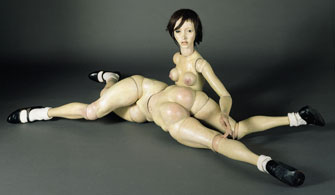Fun and Games with
The Surrealists

Victor Brauner’s “Loup-Table” (1947). Photo: Philippe Migeat, Centre Pompidou © Adagp, Paris 2013
Not being a huge fan of Surrealism, I put off going to see the exhibition “Surrealism and the Object” at the Centre Pompidou for some time. That turned out to be a mistake, as I thoroughly enjoyed this beautifully presented exhibition, which was blessedly crowd-free when I saw it on a Thursday afternoon.
The show’s elegant design has nothing surreal about it but creates a pleasing ambience with low lighting, jazzy music or sound effects, and screens that serve as walls between rooms and on which films, blowups of some of the exhibits or quotations from the artists are projected.
The exhibition starts with a number of familiar pre-Surrealist objects, including readymades by Marcel Duchamp – “Porte-bouteilles (Hérisson)” (1914/64, a bottle rack; the artist’s first readymade) and “In Advance of the Broken Arm” (1915/64, a snow shovel) – as well as a number of “rayographs” by Man Ray and a couple of paintings by Giorgio de Chirico.
There were a few pieces that were new to me, however, among them “Cadeau” (“Gift,” 1921/70), one of Man Ray’s witty “incongruous objects”: a flatiron with menacing spikes sticking out of the flat part.
A little farther along comes one of the delights of the exhibition: a whole roomful of Alberto Giacometti’s early Surrealist sculptures, so elegant, suggestive and mysterious that they made me wish he had never switched to making tall, skinny figures.
In the early 1930s, Giacometti allied himself with the Surrealists, making only “sculptures that appeared fully formed in my mind and confining myself to reproducing them in space without changing anything.” When he started using models again, it led to his break with Surrealism, which he later saw as a passing phase in his development.
In a hallway running alongside the rooms full of Surrealist works are pieces by contemporary artists that show the influence of their Surrealist forebears, among them some truly grotesque photos with sexual and scatological themes by Cindy Sherman. There is nothing by the Chapman brothers here, but it is just as well, because the works by Hans Bellmer,

“La Poupée” (1933-36), by Hans Bellmer. Photo: Philippe Migeat, Centre Pompidou © Adagp, Paris 2013dating from the 1930s, show that they didn’t invent anything new with their sculptures of grafted-together body parts.
The show also re-creates a few key Surrealist exhibitions from the past, including one that displayed Surrealist creations alongside found objects – readymades – with a surreal aspect, among them a stuffed anteater and a lumpy natural formation of sandstone that could easily be mistaken for a Louise Bourgeois sculpture.
The film footage of these historic exhibitions is worth watching (one seated viewer, an enraptured young woman, is actually a highly realistic DreamDoll). I especially enjoyed the film of “Le Surréalisme en 1947,” a show at the Galerie Maeght in Paris, which was meant to offer the world a “creative rebirth” and a “new myth” after the traumas of the war. In one scene, amused and bemused visitors watch through iron bars while a group of men sit around a table eating a lavish meal served on the prone body of a naked woman. The label offers no explanation of this scene, and an Internet search yielded only some very unsavory results, none of them mentioning the Surrealists.
You might wonder why works by some non-Surrealists like Picasso are included in the exhibition. So do I. For the power of their names? But I suppose the Picasso sculptures made from found objects could be considered to be inspired by Surrealism.
The show ends with a large room filled with playful sculptures in primary colors made of everyday objects by Joan Miró.
The exhibition raised my opinion of Surrealism by putting it in the context of its times and made me realize what a debt many contemporary artists owe to it. Many Surrealist works, like much art made today, are little more than sight gags, which may explain why the show entertained me so much, but once you get the joke, there is no real reason to see them again. Others, however, are more thought-provoking and leave a lasting impression.
Centre Pompidou: 19, rue Beaubourg, 75004 Paris. Tel.: 01 44 78 12 33. Open 11am-9pm. Closed Tuesday. Métro: Rambuteau. Admission: €11-13. Through March 3, 2014. www.centrepompidou.fr
Reader Richard Ewen writes: “I think Picasso’s inclusion importantly implies the cross-influence of the artists active during the Surrealist movement. With hindsight, we don’t classify him as a Surrealist, but think of his surreal horse figures and tortured twisted bodies in “Guernica,” made in response to the Nazi bombings in Spain in the late 1930s.”
Reader reaction: Click here to respond to this article (your response may be published on this page and is subject to editing).
Please support Paris Update by ordering books from Paris Update’s Amazon store at no extra cost. Click on your preferred Amazon location: U.K., France, U.S.
More reviews of Paris art shows.
© 2014 Paris Update
Favorite